All about stucco in interior design
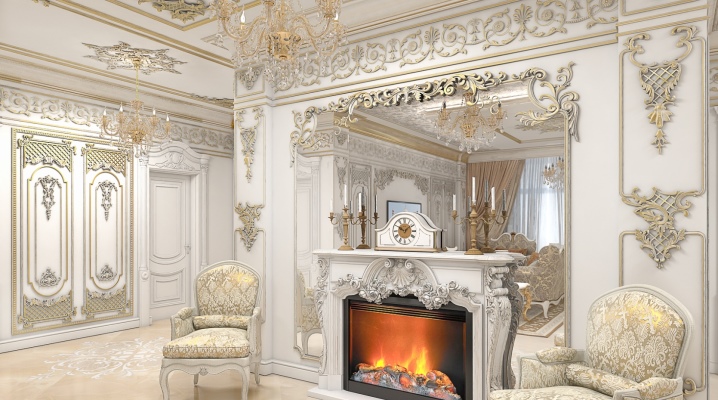
Interior decoration with volumetric stucco molding originated in ancient times, and today this trend in design has not lost its relevance. There is a misconception that stucco decoration is suitable only for luxurious mansions, however, you can decorate an ordinary apartment with a volumetric pattern if you skillfully approach this issue. Stucco decoration allows not only to visually make the room non-standard, but also helps to create accents that emphasize the beauty of the decoration, harmoniously combined with the surrounding environment.
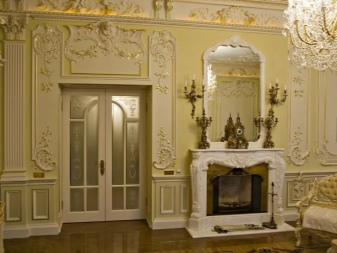


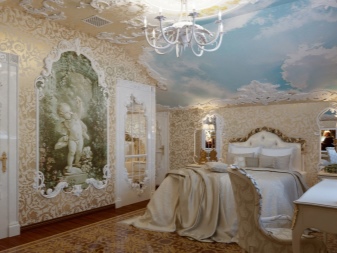
What it is?
Stucco decoration is an embossed decoration that is cast in special shapes from various materials, and such a decoration is used to decorate the ceiling or walls. Stucco traditions reached their apogee during antiquity and were widespread in the territory of Ancient Rome and Ancient Greece. During the Renaissance in Europe, stucco was already widely used in architecture. And today, stucco decors are used in certain design styles, forming its basis.
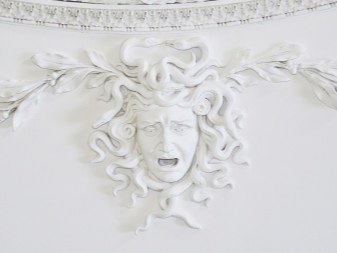
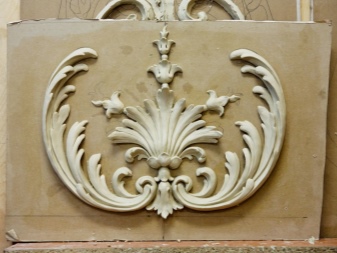
The fashion for stucco decoration did not bypass Russia either and quickly became fashionable during the reign of Peter I. For decorating buildings and interior decoration of buildings dating from the 18th and 19th centuries, the use of volumetric, skillfully executed stucco molding is characteristic.
Traditionally, stucco decorations were made from plaster, but today artificial imitation of plaster products can be made from modern and lightweight materials that have an external resemblance to plaster counterparts.
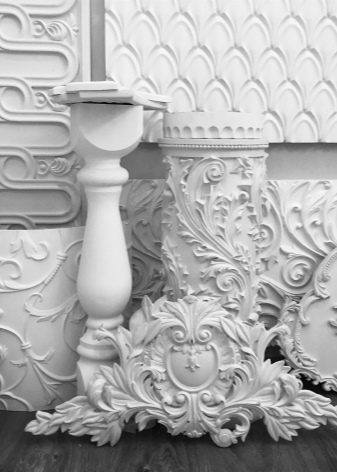
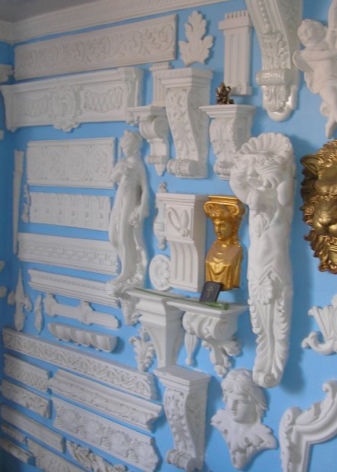
Materials (edit)
Molded decorative ornaments were made not only by casting from plaster. They were carved from solid wood, molded from wood paste mixed with gypsum. Known options for concrete, ceramics, plasterboard and polystyrene.

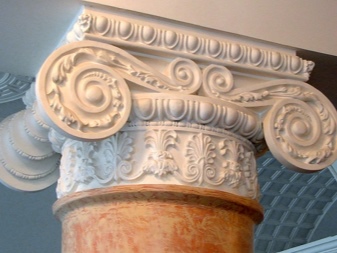
Despite the variety of components, gypsum remains the classic material for stucco molding.
Gypsum
Gypsum binder is a natural material that keeps its shape well and can be used to make any embossed decor. Even in Ancient Egypt, craftsmen noticed the properties of gypsum stone powder, which quickly solidifies after mixing it with water. Having prepared such a mixture, it was poured into certain forms of stone, and after drying, it was processed.

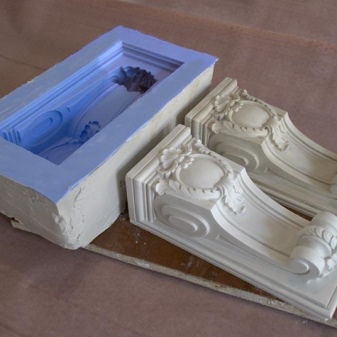
Natural gypsum does not contain impurities harmful to human health, it can withstand temperature fluctuations, it is easy to process and paint. Gypsum stucco molding in rooms plays the role of a moisture regulator, since the porous surface of the material is hygroscopic, and when the moisture level decreases, the material gives it to the external environment.

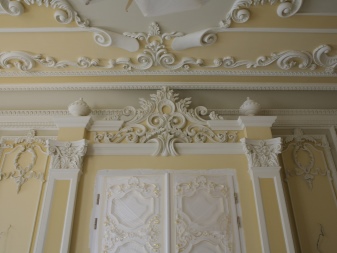
A significant disadvantage of plaster decor is its heavy weight, which greatly complicates the installation work. In addition, the hardened gypsum is a rather brittle material, it can be broken or damaged, the fragment spalling off. The cost of plaster decorative elements is the highest, besides, installation work will not be cheap, since only high-level professionals can perform them.
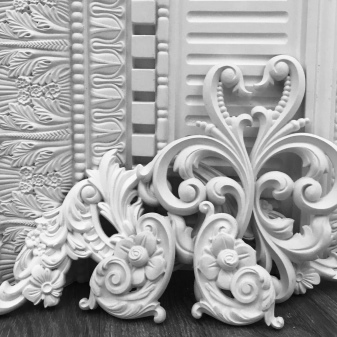
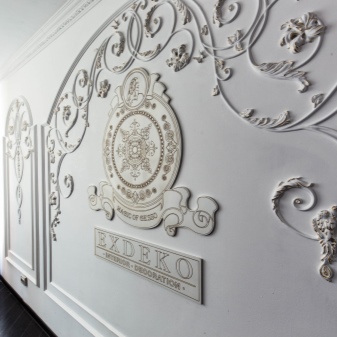
Styrofoam
The most lightweight products that imitate gypsum stucco molding are made from expanded polystyrene, which has another name - polystyrene. The cost of such decorative elements is the most affordable, and in appearance they are similar to natural gypsum. Foam decor has a number of features that complicate its use.

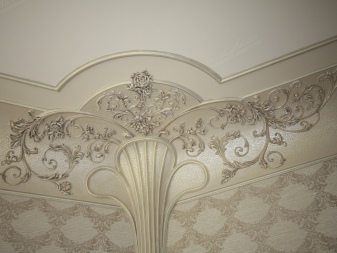
It is easy to mount such decor on an adhesive composition, but in order to obtain a good result, it is necessary that the surface to be decorated is perfectly flat. Polyfoam does not have the property of plasticity, so it will not be possible to hide small surface defects with it, and with strong pressure, the material is pushed or broken. In addition, coloring polystyrene foam also presents difficulties - a granular texture of the material appears under the layer of paint, therefore, for high-quality tinting of the product, you will need to apply several layers of water-based paint.
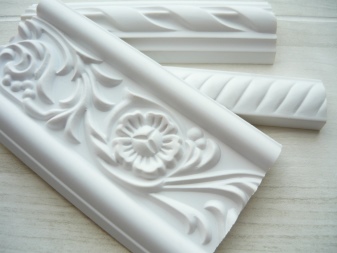

A variety of expanded polystyrene is a volumetric type of duropolymer, which is also produced by extrusion.
The difference from polystyrene is that charcoal is added to polystyrene, therefore, in terms of their structure, the products are much denser and have a greater margin of safety.
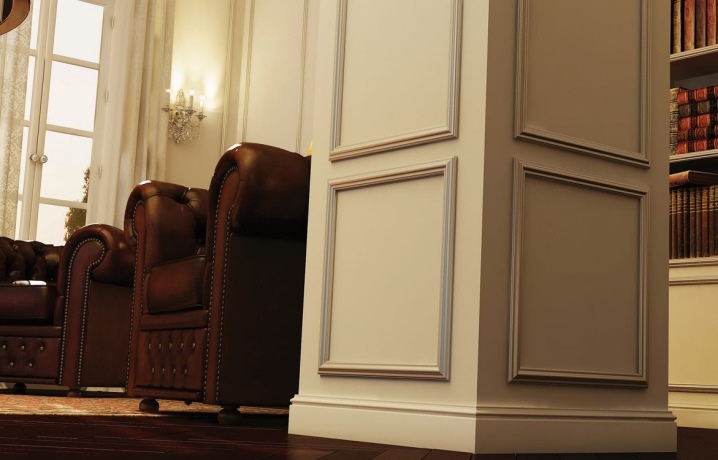
Polyurethane
Modern production technologies make it possible to produce decor imitating plaster from polymeric materials, which include polyurethane. Using the casting technique, pilasters, columns, fireplace portals, baseboards, moldings, ceiling rosettes and other decorative elements are made from it. The cost of polyurethane stucco molding is much cheaper than the gypsum counterpart, but more expensive than foam products. Polyurethane decor has a high degree of durability, it is lightweight, elastic and durable.

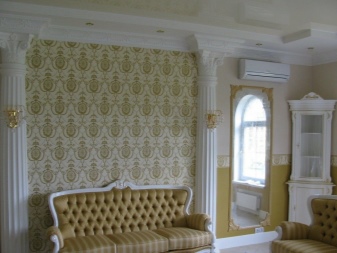
Polyurethane products are UV resistant, so they never turn yellow or dry out. The material is able to withstand changes in temperature conditions. Due to the lightness of the material, it is easy to install it using polymer adhesives. Often, polyurethane decor is covered with gilding or bronze, after which it becomes impossible to distinguish it from natural gypsum.
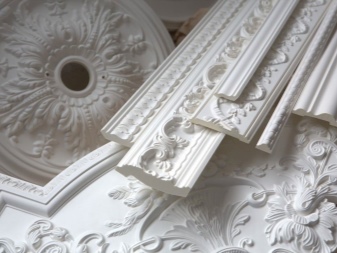
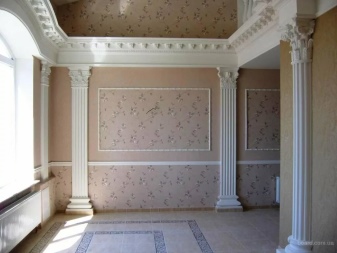
Types
Volumetric decorations are used to decorate wall and ceiling surfaces, they are used to decorate window or door openings, fireplaces, and mirrors. Depending on the purpose of application, the stucco molding has a certain configuration and dimensions.
The main decorative elements are subdivided according to the place of application into:
- decor for decorating wall surfaces - capital, rosette, panel, panel, console;
- decor for door or window openings - platbands, arches, cornices;
- decor for the ceiling surface - plinth, corner element, beam;
- universal elements - pilaster, molding, baguette, dome, column, insert.
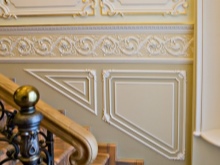
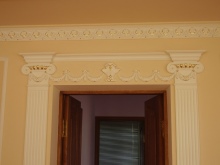
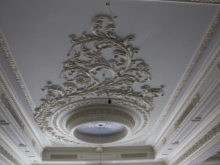
The variety of shapes and sizes makes it possible to create any composition that can be used in various design styles.
The elements
The general canvas of a three-dimensional picture, created with the help of stucco elements, is assembled from disparate parts and is somewhat reminiscent of a designer. Every detail for decorating a floor or walls has its own purpose, be it columns, an arch, friezes or a bracket. Volumetric molded products made of various materials have their own characteristics.
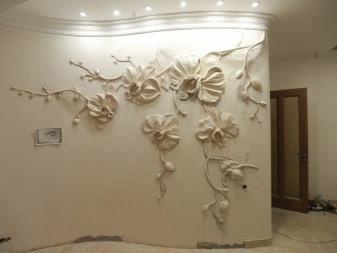
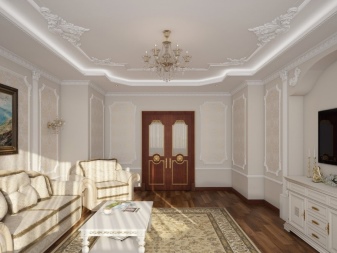
Sockets
With the help of sockets, they decorate the places where the chandeliers are mounted on the ceiling surface, but they are also used as an independent decor. Stucco rosettes become a necessary part of the interior decoration, if stucco elements are already present in it.
The main function of the socket is to emphasize the beauty and merits of the lighting fixture - a chandelier.
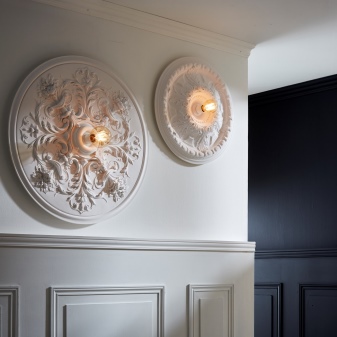
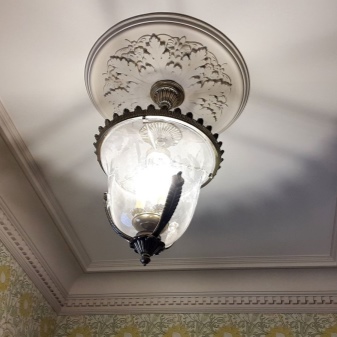
When choosing an outlet, it is important that it is in harmony with the rest of the decorative elements and does not visually overload the space. A hole is provided in the socket for attaching the chandelier, and if this product is made of polyurethane, then it is cut with a knife, depending on the thickness of the mounting rod. After installation, the hole will be closed with a special cap.
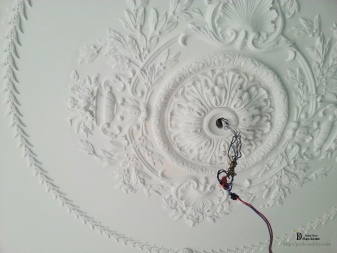
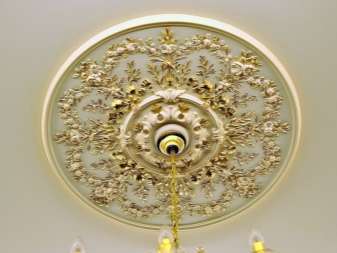
Consoles
A special type of brackets is called a console and is a fragment of a cornice intended for decorative finishing.This stucco element is used to emphasize the style of the interior, to complement it and add a touch of individuality. Consoles are used to assemble columns or arched openings. Often, the console is used as a stylized shelf on which a beautiful vase or figurine can be placed. In addition, consoles are used in those rooms where the presence of any shelves is not provided for by the design style.
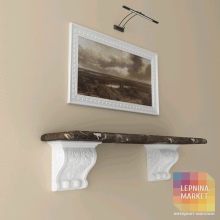

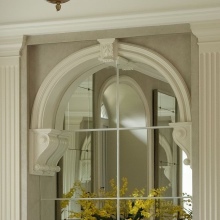
Caissons
They are square elements with recesses that are used to decorate the ceiling or on the inner surface of an arched structure. Initially, caissons were used in the architecture of Ancient Greece, when such elements could facilitate an arched structure. Over time, decorative counterparts have become an integral part of the interior.
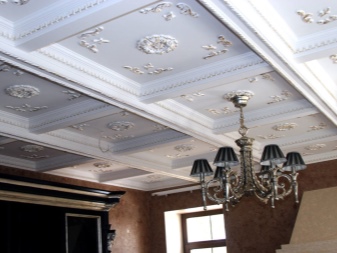

The caissons can also be decorated with a pattern or stucco pattern. Modern plaster or polymer caissons emphasize the style and personality of the room being decorated. These details look pretty nice if they are located on the ceiling and are backlit.


Domes
The traditional use of domes took place in Roman architecture, when they were used for church temples or other socially significant structures. Later, this trend came to Europe, and today the Baroque or Renaissance style in the design direction is unthinkable without the use of these volumetric elements. Domes were not used in home buildings, since this was the prerogative of palace buildings.
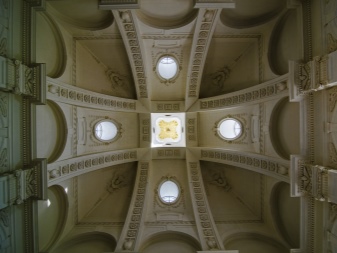
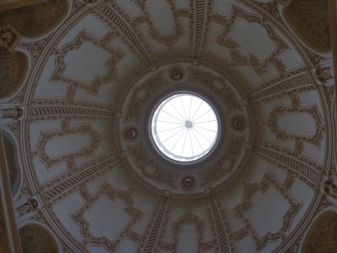
Currently, polyurethane domes are used in the interior in the form of ceiling rosettes, where the chandelier is attached.
With the help of such an element, the illusion of the depth of the ceiling and its height is created.
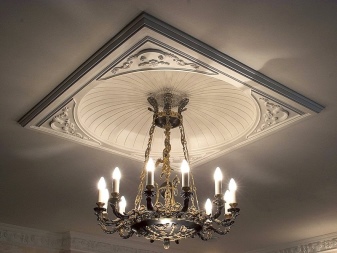
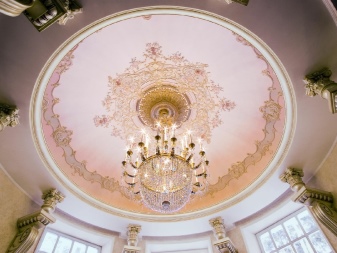
Design
Interior decorative stucco moldings were used not only indoors, but also outside, on houses. In modern design, artistic modeling is not applicable in all styles, if it comes not only to the plinth, when decorating multi-level or stretch ceilings or placing a ceiling rosette under a chandelier.


The stucco molding can be the basis of the decor in the following style directions.
- Renaissance - according to the traditions of the ancient Romans and Greeks, such decor is designed to emphasize luxury and abundance. The idea of wealth manifests itself in deliberately spacious rooms, where there are colored stucco moldings, hand-painted on the ceiling and walls, and columns and arches are placed near the openings of windows and doors. Furniture made of natural solid wood, made in light colors, completes the image of a luxurious decoration. The drawing of the volumetric decor is allowed to be varied - half-naked figures of people and angels, shoots and flowers, ornament in the form of leaves, fruits, amphorae, the image of chimeras, fantasy patterns are appropriate.
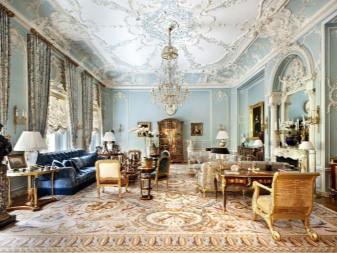

- Empire style - the luxurious interior allows you to emphasize not only elegant furniture and paintings on the walls, but also rich stucco moldings. All this is combined with gilding, which is present in abundant quantities. Typical motives for decoration are scenes from a hunt or a feast. Stucco elements can depict ornaments with oak branches, bows and arrows, warlike motifs, laurel wreaths, Roman double-headed eagles and female figures in flowing robes. In an apartment, such luxury is unlikely to be appropriate, but in public premises and spacious halls, this style looks very original.
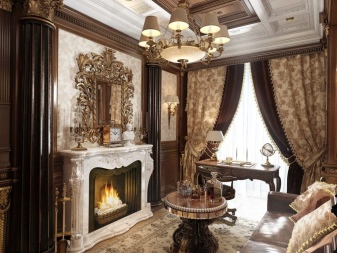
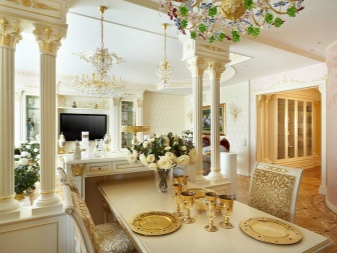
- Art deco - displays the 20s of the last century. The style contains elements of luxury and bourgeois traditions. In addition to stucco molding, the interior is decorated with skins of wild animals, and attention is drawn to the windows with the help of expensive curtains; a bas-relief from hunting scenes can be placed above the door. In the Art Deco style, excesses are not allowed, therefore, preference is given to strict forms and laconic correct lines. The volumetric stucco molding decorating such a room can combine elements of flowers, birds, animals. An indispensable attribute that attracts the eye can be a stove for heating a house.
The stove may have a restrained design and patterned tiles.
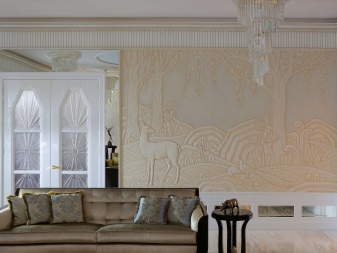
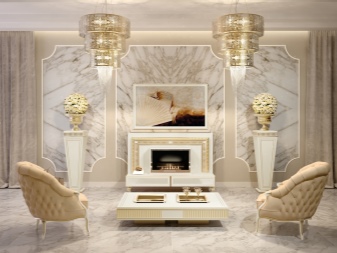
- Baroque - characterized by deliberate solemnity and pretentiousness. The design task is to visually expand and increase the space in all available ways. Decorating styles can be rich in components such as columns, stucco garlands of greenery and flowers, framed mirrors. This decor can be arranged in the bedroom or in the living room. The stucco molding contains fruits, flowers, complex ornaments of geometric shapes, nets with small rosettes.
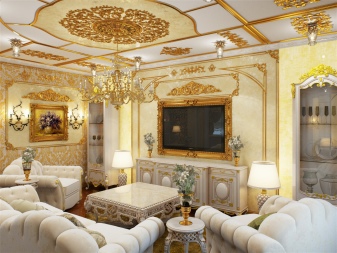

- Classicism - this style is always restrained and straightforward in its forms. The design classics, despite their solemnity, look calm and neat. Stucco elements contain geometric shapes and ornaments from them, simple motifs with interweaving of flowers and leaves, birds, combinations of rosettes, torches, straight lines. This option would be appropriate for a study or library.

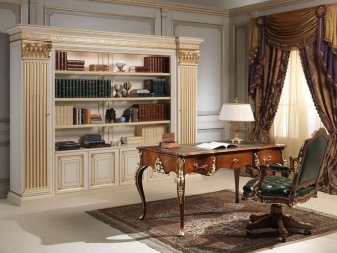
- Modern - is considered the most popular style that does not tolerate symmetry. This feature allows it to blend harmoniously into any space and decorate it with simplicity and grace. Stucco molding elements used for decoration contain any components of wildlife - it can be vegetation, birds, animals, people, streams of water, ribbons, flowing lines, brushes.
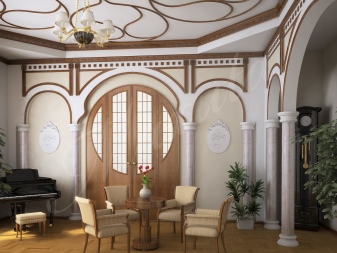
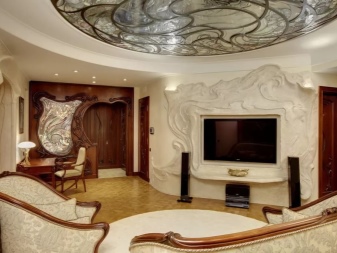
The use of stucco molding to decorate the interior of the premises allows you to achieve the effect of harmony and grace, visually expand the space, make it especially individual and attractive.
How is it produced?
The production of stucco decoration is a painstaking and complex process. First, an impression is made from the ornament, according to which a mold is then made for casting exact copies. Molds can be made of metal or polymer.
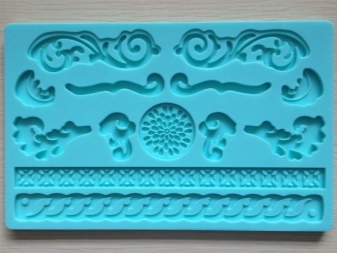
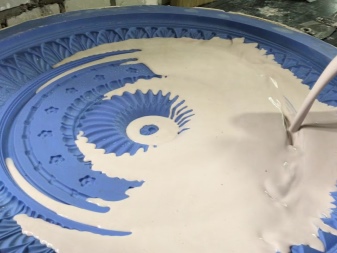
Metal forms are more difficult to manufacture, but in the end they give the clearest contours of the pattern, so the products produced in this way are more expensive. Silicone molds are used more often, but their shelf life is limited. The quality of stucco molding from silicone molds is slightly lower, so its cost is reduced.
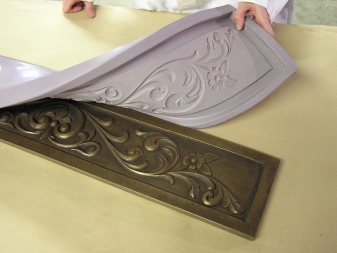
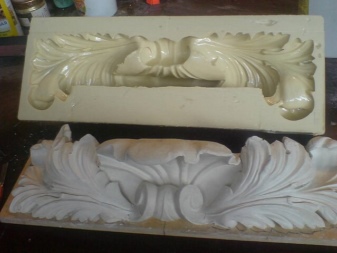
To make high-quality castings, a variety of materials are used that are able to quickly harden and form a durable product without cracks or dents. Gypsum, papier-mâché, cement, and also polymers are used as raw materials for stucco molding. Modern manufacturers began to use fiberglass composite additives to give strength to products, as well as polystyrene and polyurethane to make imitation gypsum analogues.
Classical stucco molding in factories is made by pressing. In some cases, for example, when ordering individual lots, molds and pouring are done manually.
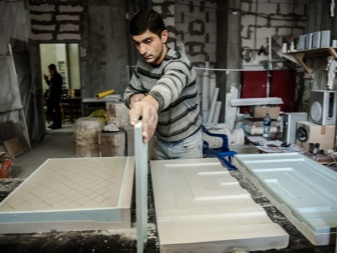

Installation and restoration
The decoration of the room with stucco molding is carried out by mounting it on a special glue. Previously, the working surface will need to be leveled, plastered, primed and dried. Before the start of installation work, the material is allowed to acclimatize for a day in the room where it will be mounted.
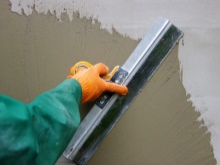
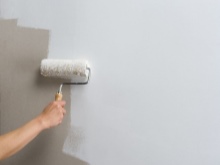

During installation, the adhesive is evenly applied to the inner surface of the decor, and then brought to the surface to be decorated and pressed firmly until the glue begins the polymerization process. If the decor is heavy, then it is attached to the surface using self-tapping screws, and the holes in the material after installation are closed with putty. Repair and restoration of damaged stucco elements is performed with acrylic sealant or putty.
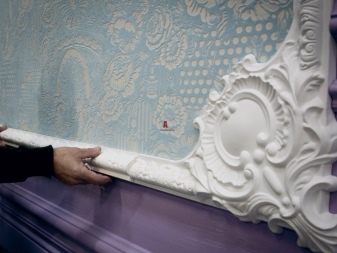
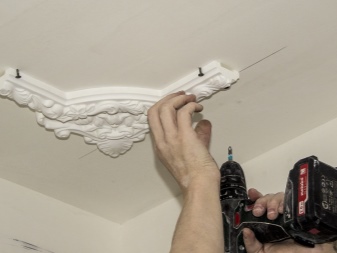
Stucco molding is often tinted in the desired color. Painting can be done by hand using water-based paint.
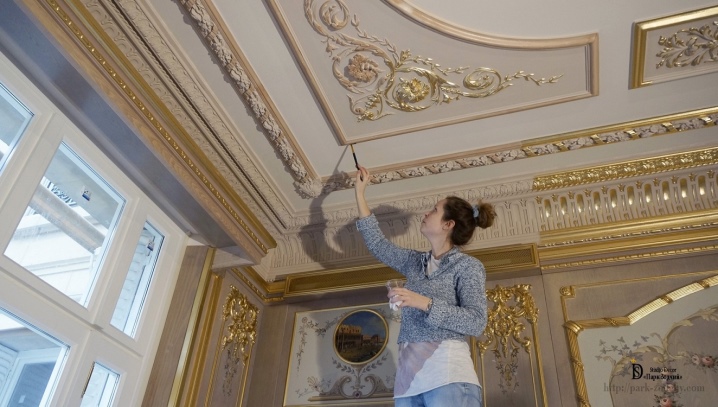
Beautiful examples
- Stucco decor looks attractive if the room has a lot of space and high ceilings. In the ascetic version, a wall panel, ceiling rosettes or other few elements are used.

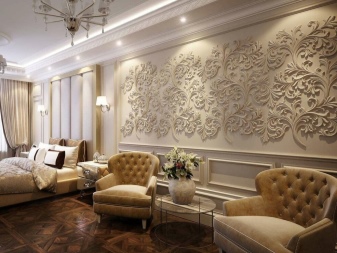
- Stucco molding emphasizes the beauty of multi-level ceilings.
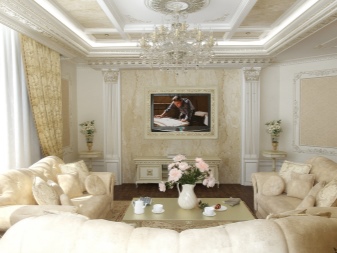
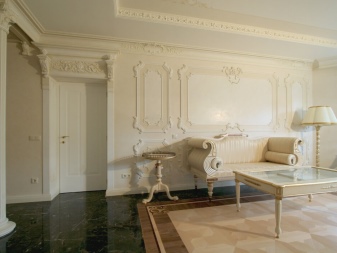
- In the kitchen, stucco molding does not seem superfluous if the room is large and spacious.

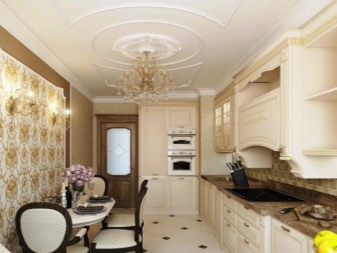
- In the bedroom, three-dimensional decor adds softness and comfort.

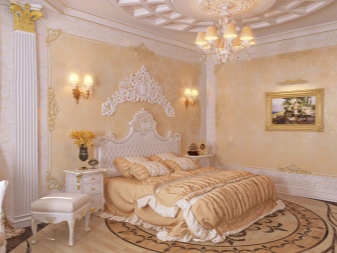
- The most common finishing method is a skirting board.

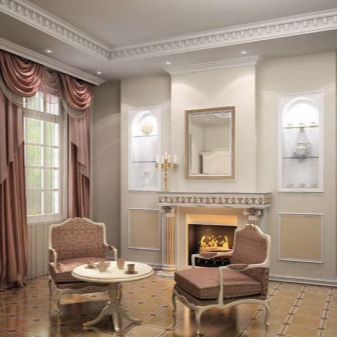
For information on what is better to use for the production of stucco molding - gypsum or polyurethane, see the next video.













I have always liked stucco molding, since childhood. At first I saw it in films, I liked it somehow. Then I saw a couple of interiors with stucco molding live, I was also delighted. All this led to the fact that my husband and I did the installation of stucco molding in our apartment. We chose polyurethane stucco molding. Gypsum was also considered, but still they decided to choose this material, since it is more practical.
The comment was sent successfully.